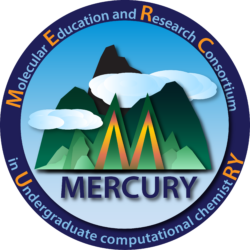3rd MERCURY CONFERENCE IN
COMPUTATIONAL CHEMISTRY
KEYNOTE SPEAKERS

Thursday, July 29 to Saturday, July 31, 2004
Mark Tuckerman, New York University, Department of Chemistry and Courant Institute of Mathematical Sciences
Rigoberto Hernandez, Georgia Tech, School of Chemistry and Biochemistry
Wendy Cornell, Novartis
Jimmie Doll, Brown University, Chemistry Department
Sharon Hammes-Schiffer, Pennsylvania State University Department of Chemistry
Jurgen Schnitker (not in picture), Wavefunction, Inc.
Veronica Vaida (not in picture), University of Colorado, Department of Chemistry and Biochemistry
Molecular Modeling Studies on Nuclear Receptors
Wendy Cornell
Nuclear receptors are recognized therapeutic targets and a number of drugs currently on the market interact with members of this class of proteins. This talk describes molecular modeling studies carried out on the Estrogen Related Receptor (ERR) and Glucocorticoid Receptor (GR). In both cases, 3D protein models were constructed based on the x-ray crystal structures of related proteins. The model of ERR was used to assess the structural basis for the constitutive activity of this orphan receptor, which is closely related to Estrogen Receptor (ER) in sequence and activity. Computational alanine scanning studies were carried out by generating molecular dynamics trajctories for ERR and ER using the AMBER software in order to evaluate the contribution of different active site residues to the ligand binding properties of each receptor. This information has contributed to the understanding of the structure-function relationships for ERR and ER. The model of GR was employed in the evaluation of hits from an experimental high throughput screening assay. Using medium throughput docking and pharmacophore screening techniques, a diverse set of active compounds were identified.
References:
K. Nam, P. Marshall, R. Wolf, and W.D. Cornell, “Simulation of the Opposing Biological Activities of Diethylstilbestrol (DES) on Estrogen Receptor a and Estrogen-Related Receptor g,” Bioploymers, 2003, 68, 130-138.
W.D. Cornell, P. Cieplak, C. I. Bayly, I.R. Gould, K.M. Merz, Jr., D.M. Ferguson, D. C. Spellmeyer, T. Fox, J.W. Caldwell, and P.A. Kollman, “A Second Generation Force Field for the Simulation of Proteins, Nucleic Acids, and Organic Molecules,” Journal of the American Chemical Society , 1995, 117, 5179-5197.
Structure and Dynamics of Clusters: Concepts, Methods, and Applications
Jimmie Doll
Increasingly, however, chemistry is entering an era in which the fundamental components of the constructionist phase of the problem often are themselves complex, pre-assembled objects. Novel magnetic materials can, for example, be prepared through the self-assembly of colloidal clusters. We will describe to address a number of issues of general concern with respect to predicting-characterizing-controlling the structure and dynamics of such cluster-based precursors. We propose techniques that essentially invert the logic of the minimization problem. Instead of searching for the minimum energy structures of specified energy landscapes, we strive instead to reshape those landscapes and thereby to exercise control over selected physical systems.
References:
1. Dubravko Sabo, D. L. Freeman, and J. D. Doll, “Taming the Rugged Landscape: Techniques for the Production, Reordering and Stabilization of Selected Cluster Inherent Structures,”, J. Chem. Phys. 118, 7321 (2003).
2. Markus Meuwly and J. D. Doll, “Dynamical Studies of Mixed Rare Gas Clusters: Collision Induced Absorption in (Ne)n (Ar)m ( n + m ¾ 30 ),” Phys. Rev. A 66, 023202 (2002).
3. Cristian Predescu, Dubravko Sabo, David L. Freeman, and J. D. Doll, “Energy Estimators for Random Series Path Integral Methods,” J. Chem. Phys. 119, 10475 (2003).
Hydrogen Tunneling and Protein Motion in Enzyme Catalysis
S. Hammes-Schiffer
Simulations of enzyme reactions provide insight into the mechanism at the atomic level. This talk will present hybrid quantum-classical molecular dynamics simulations of proton and hydride transfer reactions in enzymes. This hybrid approach includes electronic and nuclear quantum effects, as well as the motion of the entire solvated enzyme. It allows the calculation of rates and kinetic isotope effects for comparison to experiment and elucidates the fundamental nature of the nuclear quantum effects such as zero point energy and hydrogen tunneling. This approach also provides insight into the relation between specific enzyme motions and catalytic activity. The application of this approach to hydride transfer in the biochemically important enzyme dihydrofolate reductase will be discussed. An analysis of the simulations leads to the identification and characterization of a network of coupled promoting motions that extends throughout the enzyme and involves motions spanning a wide range of timescales. These coupled motions represent conformational changes that occur along the reaction pathway to facilitate the charge transfer process. This type of network has important implications for protein engineering and drug design.
SUGGESTED READING:
(1) P. K. Agarwal, S. R. Billeter, P. T. Rajagopalan, S. J. Benkovic, and S. Hammes- Schiffer, “Network of coupled promoting motions in enzyme catalysis,” Proc. Nat. Acad. Sci. USA 99, 2794-2799 (2002).
(2) S. J. Benkovic and S. Hammes-Schiffer, “A perspective on enzyme catalysis,” Science 301, 1196-1202 (2003).
(3) J. B. Watney, P. K. Agarwal, and S. Hammes-Schiffer, “Effect of mutation on enzyme motion in dihydrofolate reductase,” J. Am. Chem. Soc. 125, 3745-3750 (2003).
(4) S. Hammes-Schiffer, “Quantum-classical simulation methods for hydrogen transfer in enzymes: A case study of dihydrofolate reductase,” Curr. Opin. Struct. Biol. 14, 192-201 (2004).
The virtual laboratory: Theoretical investigations of chemical and biophysical processes via molecular dynamics
M. Tuckerman
Molecular dynamics, the technique in which Newton’s equations of motion for a given system are solved numerically subject to initial and boundary conditions, has become one of the most important methods for theoretical investigations of complex condensed phase processes. Newton’s equations specify how the individual atoms in a system move under the action of the forces between them, and hence it is necessary to specify these forces in order to perform a molecular dynamics calculation. This can be accomplished either by postulating an empirical force law, in which simple functional forms are used to describe chemical bond, electrostatic and Van der Waals interactions, or by computing the forces directly from the electronic Schrodinger equation at each step in the calculation. The former method very large systems, such as proteins and other biological macromolecules in solution to be studied over very long time scales but are inherently inaccurate. The latter method, known as ab initio molecular dynamics (AIMD), allows chemical reactions, where bonds are broken and formed, to be studied with a high degree of accuracy but requires large amounts of computer time while permitting access only to very short time scales. Despite these limitations, AIMD has had a very significant impact in a number of application areas of chemical, biological and technological importance. In this talk, I will discuss the AIMD technique and describe several such applications. I will demonstrate how AIMD has elucidated the underlying microscopic mechanisms of long-range proton transport in hydrogen-bonded liquids and solids, a problem of importance in the design of proton-exchange membranes for fuel cells, and I will show how AIMD has yielded new insights into how conjugated dienes interact with semi-conductor surfaces, a problem of current interest in molecular electronics.
Sunlight initiated atmospheric photochemistry
V. Vaida
Absorption of solar radiation by atmospheric molecules and by their complexes, boosts that molecule’s energy content above that determined by the local temperature. This energy may be dissipated by collisions, bringing the molecule back into Boltzmann equilibrium with the surrounding atmosphere, or may be used to effect chemical change. Solar wavelengths capable of radical formation in the atmosphere are typically in the UV spectral region. Absorption by oxygen in the upper atmosphere and by ozone in the stratosphere gives an altitude and solar zenith angle dependence to the solar spectrum. Generally, one considers atmospheric photochemical reactions to take place in electronically excited states. This presentation will use the example of OClO photochemistry to exemplify such ultraviolet initiated reactions.
Photons in the visible region of the solar spectrum are much more abundant than those of higher energies at all altitudes and solar zenith angles. Visible radiation is not at energies capable of exciting electronic transitions and therefore is seldom considered to be a driving force in atmospheric photochemistry. The possibility of promoting ground electronic state photochemistry via excitation by visible radiation of vibrational overtone transitions will be illustrated with the example of H2SO4 and of its hydrate. Sulfuric acid hydrate will be used to illustrate the role of molecular complexes in atmospheric chemistry and climate.
“Photoisomerisation of OClO: a Polar Ozone Depletion Mechanism?” V. Vaida, S. Solomon, E. C. Richard, E. Ruhl and A. Jefferson, Nature, 342, 405 (1989).
“The Photoreactivity of Chlorine Dioxide,” V. Vaida and J. D. Simon, Science, 268, 1443 (1995).
“Photolysis of sulfuric acid vapor by visible solar radiation” V. Vaida, D. J. Donaldson, H. G. Kjaergaard, P. E. Hintze Science 299, 1566-1568 (2003)
“Hydrated complexes: relevance to atmospheric chemistry and climate” V. Vaida, H. G. Kjaergaard, and K. J. Feierabend Int Reviews in Physical Chemistry 22, 203-219 (2003)
“ Atmospheric photochemistry via vibrational overtone absorption” D. J. Donaldson, A. F. Tuck and V. Vaida Chem. Rev. 103, 4717-4729, (2003)
Nonequilibirum Chemistry in Complex Environments
Rigoberto Hernandez
Chemical reactions or dynamical events of practical interest often take place in solvents that are neither homogeneous in space nor invariant in time. Such complex environments can not be simply described using stationary linear response theories. All of the research problems in the Hernandez group can be cast in this context(requiring the treatment of complex environments) and will be briefly reviewed at the start of the presentation. [See, e.g., R. Hernandez and F. L. Somer, Jr. in “Theoretical Methods in Condensed Phase Chemistry” edited by S.~Schwartz (Kluwer Academic, The Netherlands,2000), p.91-116.] The remainder of the presentation will discuss the possibility that the dynamics of a diffusing adsorbate may be affected by the correlated fluctuations of a silicon or metal surface. The complex dynamics of this surface is modeled herein through a stochastic potential energy surface which is nonlocal in time and space. Rates and transport across these surfaces have been obtained for one- and two- dimensional particles coupled to environments ranging from the typical high friction regime down to low friction. In the intermediate to low friction regime relevant to the surface-adsorbate system, the energy from the stochastic surface leads to deviations in thermal equilibrium. Through a naive renormalization of the friction, these deviations have been tamed in previous work.[T. D. Shepherd and R. Hernandez,J.Chem.Phys. 115, 2430-2438 (2001), J. Phys. Chem. B, 106, 8176-8181 (2002).] An alternative and more detailed approach requires the use of a space-dependent friction correction. The formalism and comparison between the models will be presented. Enhancements in the rates have been found in one-dimensional aperiodic stochastic potentials. This leads to the possibility of asymmetric transport on two-dimensional stochastic potentials, and it may have implications on the transport of absorbed molecules on two-dimensional surfaces.
Molecular Dynamics Simulations as an Exploratory Research Tool
Jurgen Schnitker
Molecular dynamics simulations using realistic potential functions are increasingly used as a routine research tool. The talk will link simple demonstrations that illustrate the power of the simulation approach with a few representative applications in physical chemistry, materials science, and biology. The possibilities as well as the limitations regarding the length scale, time scale, and physical accuracy of simulations will be delineated.
References:
Andrew Leach: Molecular Modeling–Principles and Applications
(Addison Wesley Longman)
Christopher Cramer: Essentials of Computational Chemistry: Theory and
Applications (Wiley)

